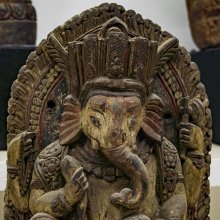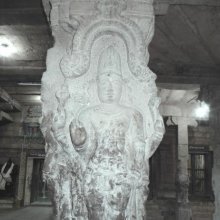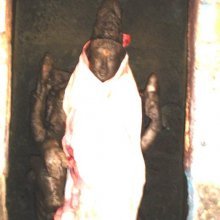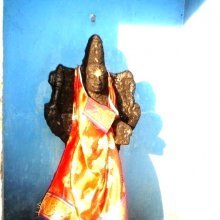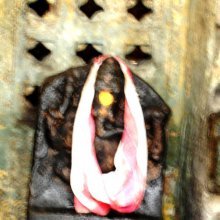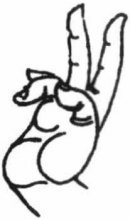Parashu, Parasu, Paraśu, Parāsu: 35 definitions
Introduction:
Parashu means something in Buddhism, Pali, Hinduism, Sanskrit, Marathi, Jainism, Prakrit, Hindi, biology. If you want to know the exact meaning, history, etymology or English translation of this term then check out the descriptions on this page. Add your comment or reference to a book if you want to contribute to this summary article.
The Sanskrit term Paraśu can be transliterated into English as Parasu or Parashu, using the IAST transliteration scheme (?).
Images (photo gallery)
(+21 more images available)
In Hinduism
Purana and Itihasa (epic history)
Source: Wisdom Library: MahābhārataParaśu (परशु)—Sanskrit word for a type of Battle-ax mentioned in the Mahābhārata.
Source: archive.org: Shiva Purana - English TranslationParaśu (परशु) refers to the “axe”, according to the Śivapurāṇa 2.4.5 (“Kārttikeya is crowned”).—Accordingly, after the Kṛttikās spoke to Kārttikeya: “[...] Then Śiva, the lord of the universe, following the worldly convention delightedly placed Kārttikeya on a beautiful gemset throne. [...] Śiva gave him the trident, the bow Pināka, the axe (paraśu), the arrow Paśupata, the weapon of destruction and the greatest lore. I gave him the holy thread, the Vedas, the mantra Gāyatrī, the vessel Kamaṇḍalu, the arrow Brahmāstra and the lore that destroys the enemy. [...]”.
Source: Cologne Digital Sanskrit Dictionaries: The Purana Index1a) Paraśu (परशु).—A son of Uttama Manu.*
- * Brahmāṇḍa-purāṇa II. 36. 39; Viṣṇu-purāṇa III. 1. 15.
1b) Also Paraśvadha: axe; the weapon presented to Rāma by Śiva to put down the Asuras.*
- * Brahmāṇḍa-purāṇa III. 24. 74, 81; 32. 58; 39. 21, 31; 40. 13; IV. 19. 84.
1c) A son of Rukmiṇī and Kṛṣṇa.*
- * Matsya-purāṇa 47. 16.

The Purana (पुराण, purāṇas) refers to Sanskrit literature preserving ancient India’s vast cultural history, including historical legends, religious ceremonies, various arts and sciences. The eighteen mahapuranas total over 400,000 shlokas (metrical couplets) and date to at least several centuries BCE.
Shilpashastra (iconography)
Source: Wisdom Library: Śilpa-śāstraParaśu (परशु, “axe”):—In Hindu iconology (śilpaśāstra), this symbol represents severing the bonds of attachment. It is also one of the objects that Agni and Yama are displayed carrying.
Source: Google Books: Elements of Hindu iconographyParaśu is the battle axe. The earlier specimens of this are light and graceful. The paraśu of the archaic type consists of a steel blade which is fitted on a turned, light, wooden handle. The handle is sometimes fixed in a ring which is attached to the balde of the axe. Sometimes, however, the blade is fixed in a hole bored in the handle. The later forms consist of a heavy club, closely resembling the gadā, into which the head of the paraśu is fitted. The balde is disproportionately small in these later forms, but is of proper proportion in the earlier types.
Source: Red Zambala: Hindu Icons and Symbols | Inner Circle IVThe axe (paraśu) of Gaṇeśa — represents non-attachment. In order to progress on the spiritual path the essential virtue to cultivate is that of non-attachment to the sense-object and their means of gratification — the noose held in the one hand needs to be cut with the axe of non-attachment in the other.
Source: Red Zambala: Hindu Icons and Symbols | IntroductionParaśu (Axe) - Non-attachment - the severing of our ties and bonds to the material world.
Source: Archaeological Survey of India: Śaiva monuments at Paṭṭadakal (śilpa)Paraśu (परशु, “battle-axe”).—The significance of paraśu, according to Vātulaśuddhāgama (paṭala 1, śloka 100, p. 40, kartā paraśur ucyate) is that which cuts off the forest (bhavāraṇya), the savage trees of life. The trident signifies the destruction of the three guṇa, sattva, rajas and tamas and the snake represents the destiny, fate.
Source: Shodhganga: The significance of the mūla-beras (śilpa)Paraśu (परशु, “axe”) represents “satya” (truth), referring to one of the attributes of Lord Śiva, commonly seen depicted in Hindu iconography, defined according to texts dealing with śilpa (arts and crafs), known as śilpaśāstras.—The śilpa texts have classified the various accessories under the broad heading of āyudha or karuvi (implement), including even flowers, animals, and musical instruments. The accessories should be made of the same material with which the main image has been fashioned. Each of these accessories denotes the attributes of the images while in certain circumstances they denote particular divinity or character by themselves. Paraśu, for example, signifies the attributes of Lord Śiva.
Paraśu is the battle-axe. The paraśu of the archaic type consists of a steel blade, which is fitted on a turned, light, wooden handle. The handle is sometimes fixed in a ring, which is attached to the blade of the axe. Sometimes, however, the blade is fixed in a hole bored in the handle. The later forms consist of a heavy club, closely resembling the gadā, into which the head of the paraśu is fitted.
Source: Shodhganga: The significance of the mūla-beras (śilpa)Śūla (शूल, “trident”) represents “satya” (truth), commonly seen depicted in Hindu iconography, defined according to texts dealing with śilpa (arts and crafs), known as śilpaśāstras.—The śilpa texts have classified the various accessories under the broad heading of āyudha or karuvi (implement), including even flowers, animals, and musical instruments. The accessories should be made of the same material with which the main image has been fashioned. Each of these accessories denotes the attributes of the images while in certain circumstances they denote particular divinity or character by themselves. Paraśu, for example, signifies the attributes of Lord Śiva.

Shilpashastra (शिल्पशास्त्र, śilpaśāstra) represents the ancient Indian science (shastra) of creative arts (shilpa) such as sculpture, iconography and painting. Closely related to Vastushastra (architecture), they often share the same literature.
Dhanurveda (science of warfare)
Source: Wisdom Library: DhanurvedaParaśu (परशु) refers to a weapon (“hatchet”, “axe”). It is a Sanskrit word defined in the Dhanurveda-saṃhitā, which contains a list of no less than 117 weapons. The Dhanurveda-saṃhitā is said to have been composed by the sage Vasiṣṭha, who in turn transmitted it trough a tradition of sages, which can eventually be traced to Śiva and Brahmā.
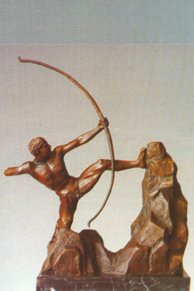
Dhanurveda (धनुर्वेद) refers to the “knowledge of warfare” and, as an upaveda, is associated with the Ṛgveda. It contains instructions on warfare, archery and ancient Indian martial arts, dating back to the 2nd-3rd millennium BCE.
Shaktism (Shakta philosophy)
Source: Google Books: ManthanabhairavatantramParaśu (परशु) refers to an “axe”, according to the Manthānabhairavatantra, a vast sprawling work that belongs to a corpus of Tantric texts concerned with the worship of the goddess Kubjikā.—Accordingly, while describing the visualization of Koṅkaṇā: “She is the most excellent of the supreme, Parā, the goddess of the Kaula of the Command of Knowledge. (She is) the wish-granting gem of sovereign power (śrī). (Her) weapons are a bow and wheel; she has a sword and an axe [i.e., paraśu], and holds a goad and a noose. She is the unfailing Koṅkaṇā, the Kaula Weapon (who holds a) bow, arrow, club, thunderbolt, and javelin. (She has big) fang-like teeth. [...]”.

Shakta (शाक्त, śākta) or Shaktism (śāktism) represents a tradition of Hinduism where the Goddess (Devi) is revered and worshipped. Shakta literature includes a range of scriptures, including various Agamas and Tantras, although its roots may be traced back to the Vedas.
Kavya (poetry)
Source: Brill: Śaivism and the Tantric Traditions (kavya)Paraśu (परशु) refers to “axes”, according to Bāṇa’s Kādambarī (p. 225-226).—Accordingly, while describing the shire of the Goddess Caṇḍikā, “[Then follows the image of the Goddess Caṇḍikā, which matches the conception of Kālarātri in the passage from the Mahābhārata:] Her feet were never bereft of cloths [dyed with] red lac thrown upon the mound of her seat [on the altar] as if they were the lives of all creatures arrived there for shelter; she resembled an inhabitant of the Underworld because of the intense darkness obstructed [only] by the flashes from axes (paraśu), spears, etc., weapons deadly for beings, that seemed to hold nets of hair (keśa-jālaka) stuck from decapitations because of the reflections of black yak-tail whisks cast [upon their surfaces]; [...]”.

Kavya (काव्य, kavya) refers to Sanskrit poetry, a popular ancient Indian tradition of literature. There have been many Sanskrit poets over the ages, hailing from ancient India and beyond. This topic includes mahakavya, or ‘epic poetry’ and natya, or ‘dramatic poetry’.
Shaivism (Shaiva philosophy)
Source: SOAS University of London: Protective Rites in the Netra TantraParaśu (परशु) refers to an “axe”, according to the Netratantra of Kṣemarāja: a Śaiva text from the 9th century in which Śiva (Bhairava) teaches Pārvatī topics such as metaphysics, cosmology, and soteriology.—Accordingly, [verse 10.1-7ab, while describing the appearance and worship of Bhairava]—“[...] He] bears a sword and shield, holds a hook and noose. [His] hand[s and posed] in the wish fulfilling and protection [mudrās. He] holds the thunderbolt of a great hero. [He also] holds an axe and a hatchet (paraśu—paraśvāyudhapāṇikam). Having worshipped Bhairava, [the Mantrin] remembers being joined in union [with] him, [in the same way as] dissolution in fire”.

Shaiva (शैव, śaiva) or Shaivism (śaivism) represents a tradition of Hinduism worshiping Shiva as the supreme being. Closely related to Shaktism, Shaiva literature includes a range of scriptures, including Tantras, while the root of this tradition may be traced back to the ancient Vedas.
Sports, Arts and Entertainment (wordly enjoyments)
Source: archive.org: Syainika Sastra of Rudradeva with English Translation (art)Parāsu (परासु) refers to “dead quarry” (killed by the Hawk), according to the Śyainika-śāstra: a Sanskrit treatise dealing with the divisions and benefits of Hunting and Hawking, written by Rājā Rudradeva (or Candradeva) in possibly the 13th century.—Accordingly, [while discussing the outlines of hawking]: “[...] The Vāj, falling from a great height on,the quarry and catching it in the right place, by its cleverness in killing its quarry (parāsu-karaṇa), affords an instance of Vīrarasa (the emotion of heroism). Attacks (ākrānti) are of three kinds, upwards, horizontal and downwards. All three attacks are very enjoyable when the Vājas attack the Varajas”.

This section covers the skills and profiencies of the Kalas (“performing arts”) and Shastras (“sciences”) involving ancient Indian traditions of sports, games, arts, entertainment, love-making and other means of wordly enjoyments. Traditionally these topics were dealt with in Sanskrit treatises explaing the philosophy and the justification of enjoying the pleasures of the senses.
In Buddhism
Tibetan Buddhism (Vajrayana or tantric Buddhism)
Source: Wisdom Library: Tibetan BuddhismParaśu (परशु) refers to one of the various Ṛṣis (sages) and Mahārṣis (great sages) mentioned as attending the teachings in the 6th century Mañjuśrīmūlakalpa: one of the largest Kriyā Tantras devoted to Mañjuśrī (the Bodhisattva of wisdom) representing an encyclopedia of knowledge primarily concerned with ritualistic elements in Buddhism. The teachings in this text originate from Mañjuśrī and were taught to and by Buddha Śākyamuni in the presence of a large audience (including Paraśu).
Source: academia.edu: The Structure and Meanings of the Heruka MaṇḍalaParaśu (परशु) refers to a “axe” and represents one of the items held in the right hand of Heruka: one of the main deities of the Herukamaṇḍala described in the 10th century Ḍākārṇava chapter 15. Heruka is positioned in the Lotus (padma) at the center; He is the origin of all heroes; He has 17 faces (with three eyes on each) and 76 arms [holding, for example, paraśu]; He is half black and half green in color; He is dancing on a flaming sun placed on Bhairava and Kālarātrī.
Source: OSU Press: Cakrasamvara SamadhiParaśu (परशु) refers to an “axe” which is used to describe Cakrasaṃvara, according to the Saṃvaramaṇḍala of Abhayākaragupta’s Niṣpannayogāvalī, p. 45 and n. 145; (Cf. Cakrasaṃvaratantra, Gray, David B., 2007).—Accordingly, [while describing the iconography of Cakrasaṃvara]: “In the Saṃvara Maṇḍala atop Mount Sumera within a vajra-canopy there is a variegated lotus, on top of that a palace, in the middle of which is the Blessed Lord, standing in ālīḍhāsana, "archer's pose", [...] possessing a vyāghracarma, "tiger skin" and twelve arms, the foremost arms holding a vajra and ghaṇṭā, embracing Vajravārāhī, the uppermost arms holding a gajacarman, "elephant skin", dripping with blood, the remaining arms holding, starting second from the top, on the right, a ḍamaru, "double-headed drum", paraśu, "axe", kartika, "flaying knife", triśūla, "trident", on the left, a khaṭvāṅga, "staff", kapāla, "skull bowl", pāśa, "noose", and brahmamuṇḍa, "lopped head of Brahma", [...]”.
Note: The paraśu, "axe", symbolizes cutting away births and deaths.
Source: MDPI Books: The Ocean of HeroesParaśu (परशु) refers to an “axe” (i.e., one of the attributes held in the hands of a deity), according to the 10th-century Ḍākārṇava-tantra: one of the last Tibetan Tantric scriptures belonging to the Buddhist Saṃvara tradition consisting of 51 chapters.—Accordingly, “[...] [He (The Causal Vajra-holder)] stands in the ālīḍha posture with the feet placed on both Hara and Gaurī [He holds] (1) a vajra and (2) a bell, (3)(4) an elephant’s skin, (5) a drum, (6) a knife, (7) an axe (paraśu), (8) a trident, (9) a skull staff, (10) a pot, (11) a noose, and (12) a hairless head in the left and right [hands]. [...]”.

Tibetan Buddhism includes schools such as Nyingma, Kadampa, Kagyu and Gelug. Their primary canon of literature is divided in two broad categories: The Kangyur, which consists of Buddha’s words, and the Tengyur, which includes commentaries from various sources. Esotericism and tantra techniques (vajrayāna) are collected indepently.
Biology (plants and animals)
Source: Google Books: CRC World Dictionary (Regional names)1) Parasu in India is the name of a plant defined with Butea monosperma in various botanical sources. This page contains potential references in Ayurveda, modern medicine, and other folk traditions or local practices It has the synonym Rudolphia frondosa Poir. (among others).
2) Parasu is also identified with Cleistanthus collinus It has the synonym Andrachne orbiculata Roth (etc.).
Example references for further research on medicinal uses or toxicity (see latin names for full list):
· Journal of Cytology and Genetics (1990)
· Étude générale du groupe des Euphorbiacées (1858)
· A Numerical List of Dried Specimens (7877)
· Journal of Economic and Taxonomic Botany (1996)
· Genera Plantarum (1880)
· Cytologia (1989)
If you are looking for specific details regarding Parasu, for example health benefits, side effects, chemical composition, diet and recipes, pregnancy safety, extract dosage, have a look at these references.

This sections includes definitions from the five kingdoms of living things: Animals, Plants, Fungi, Protists and Monera. It will include both the official binomial nomenclature (scientific names usually in Latin) as well as regional spellings and variants.
Languages of India and abroad
Pali-English dictionary
Source: BuddhaSasana: Concise Pali-English Dictionaryparasu : (m.) hatchet.

Pali is the language of the Tipiṭaka, which is the sacred canon of Theravāda Buddhism and contains much of the Buddha’s speech. Closeley related to Sanskrit, both languages are used interchangeably between religions.
Marathi-English dictionary
Source: DDSA: The Molesworth Marathi and English Dictionaryparaśu (परशु).—m (S) pop. paraśa m An ax or a hatchet.
Source: DDSA: The Aryabhusan school dictionary, Marathi-Englishparaśu (परशु).—m prop. paraśa m An axe or a hatchet.
Marathi is an Indo-European language having over 70 million native speakers people in (predominantly) Maharashtra India. Marathi, like many other Indo-Aryan languages, evolved from early forms of Prakrit, which itself is a subset of Sanskrit, one of the most ancient languages of the world.
Sanskrit dictionary
Source: DDSA: The practical Sanskrit-English dictionaryParaśu (परशु).—[paraṃ-śṛṇāti, śṝ-ku ḍicca; cf. Uṇādi-sūtra 1.34.]
1) An axe, a hatchet, a battle-axe; तर्जितः परशुधारया मम (tarjitaḥ paraśudhārayā mama) R.11.78.
2) A weapon in general.
3) A thunderbolt.
Derivable forms: paraśuḥ (परशुः).
--- OR ---
Parāsu (परासु).—a.
1) Lifeless, dead; प्राक् परासुर्द्विजात्मजः (prāk parāsurdvijātmajaḥ) R.15.56; 9.78.
2) One whose vital spirit is departed.
-parāsutā, -parāsutvam 1 Exhaustion, death; व्रजति पुरा हि परासुतां त्वदर्थे (vrajati purā hi parāsutāṃ tvadarthe) Kirātārjunīya 1.5.
2) A dependent life (parādhīnaprāṇatva); लोभान्मोहश्च माया च मानस्तम्भः परासुता (lobhānmohaśca māyā ca mānastambhaḥ parāsutā) Mahābhārata (Bombay) 12.158.4.
Source: Cologne Digital Sanskrit Dictionaries: Shabda-Sagara Sanskrit-English DictionaryParaśu (परशु).—m.
(-śuḥ) An axe, a hatchet. E. para another, śu to injure, Unadi aff. ku, ḍicca .
--- OR ---
Parāsu (परासु).—mfn. (-suḥ-suḥ-su) Dead, expired. E. para away, remote, asu vital breath.
Source: Cologne Digital Sanskrit Dictionaries: Benfey Sanskrit-English DictionaryParaśu (परशु).—i. e. para-, compounded with a derivative of śo, m. An axe, a hatchet, [Rāmāyaṇa] 1, 74, 18.
— Cf.
--- OR ---
Parāsu (परासु).—i. e. parā-asu, adj. 1. Dying, [Suśruta] 1, 114, 15. 2. Dead, Mahābhārata 1, 3835.
Source: Cologne Digital Sanskrit Dictionaries: Cappeller Sanskrit-English DictionaryParaśu (परशु).—[masculine] hatchet, axe.
--- OR ---
Parāsu (परासु).—[adjective] dying or dead (lit. whose breath is going or gone out).
Source: Cologne Digital Sanskrit Dictionaries: Monier-Williams Sanskrit-English Dictionary1) Paraśu (परशु):—m. a hatchet, axe, the axe of a woodcutter
2) ([Naighaṇṭuka, commented on by Yāska ii, 20]) a thunderbolt, [Ṛg-veda] etc. etc.
3) Name of a king, [Mahābhārata]
4) [wrong reading] for parśu q.v. (cf. [Greek] πέλεκυς, πέλεκκον, etc.)
5) Parāsu (परासु):—mfn. one whose vital spirit is departed or departing
6) dying or dead, [Mahābhārata; Kāvya literature etc.]
7) Parāsū (परासू):—[=parā-√sū] [Parasmaipada] -suvati ([Aorist] -sāvīḥ), to frighten away, [Ṛg-veda; Atharva-veda; Vājasaneyi-saṃhitā; Taittirīya-saṃhitā]
Source: Cologne Digital Sanskrit Dictionaries: Yates Sanskrit-English Dictionary1) Paraśu (परशु):—(śuḥ) 2. m. An axe, a hatchet.
2) Parāsu (परासु):—[(suḥ-suḥ-su) a.] Dead.
Source: DDSA: Paia-sadda-mahannavo; a comprehensive Prakrit Hindi dictionary (S)Paraśu (परशु) in the Sanskrit language is related to the Prakrit words: Parasu, Parāsu, Pharasu.
[Sanskrit to German]
Sanskrit, also spelled संस्कृतम् (saṃskṛtam), is an ancient language of India commonly seen as the grandmother of the Indo-European language family (even English!). Closely allied with Prakrit and Pali, Sanskrit is more exhaustive in both grammar and terms and has the most extensive collection of literature in the world, greatly surpassing its sister-languages Greek and Latin.
Hindi dictionary
Source: DDSA: A practical Hindi-English dictionaryParaśu (परशु) [Also spelled parshu]:—(nm) a battle axe; ~[dhara] one who wields a [paraśu]; see ~[rāma; ~rāma] the great son of the seer Jamdagni, and a sworn enemy of the kshatriyas, who annihilated the kshatriyas twenty-one times and ultimately suffered a defeat at the hands of [rāma].
...
Prakrit-English dictionary
Source: DDSA: Paia-sadda-mahannavo; a comprehensive Prakrit Hindi dictionary1) Parasu (परसु) in the Prakrit language is related to the Sanskrit word: Paraśu.
2) Parāsu (परासु) also relates to the Sanskrit word: Parāsu.
Prakrit is an ancient language closely associated with both Pali and Sanskrit. Jain literature is often composed in this language or sub-dialects, such as the Agamas and their commentaries which are written in Ardhamagadhi and Maharashtri Prakrit. The earliest extant texts can be dated to as early as the 4th century BCE although core portions might be older.
Kannada-English dictionary
Source: Alar: Kannada-English corpusParaśu (ಪರಶು):—[noun] an axe that has a crescent-shaped blade with a relatively short handle, used in warfare of olden days.
--- OR ---
Parasu (ಪರಸು):—
1) [verb] to express one’s good wishes in a solemn form, as for another’s prosperity, victory, goodlife, protection against harm, evil., etc.; to bless solemnly.
2) [verb] to convey one’s good wishes for another.
3) [verb] to undertake a religious vow.
4) [verb] to recite a prayer and ask earnestly the god for something.
5) [verb] to praise; to commend; to admire; to extol.
--- OR ---
Parasu (ಪರಸು):—[noun] = ಪರಶು [parashu].
--- OR ---
Parāsu (ಪರಾಸು):—[adjective] no longer living; deprived of life; dead.
--- OR ---
Parāsu (ಪರಾಸು):—[noun] a dead person.
Kannada is a Dravidian language (as opposed to the Indo-European language family) mainly spoken in the southwestern region of India.
See also (Relevant definitions)
Partial matches: Para, Cu, Shu.
Starts with (+19): Parashuci, Parashuddhi, Parashudhara, Parashudharin, Parashudharini, Parashuhasta, Parashuka, Parashula, Parashumant, Parashumat, Parashumudra, Parashunabha, Parashupalasha, Parashupanika, Parashuphanta, Parashurama, Parashurama gurjara, Parashurama mishra, Parashurama muni, Parashurama shastrin.
Ends with: Ashvaparashu, Khandaparashu, Mayavadaparashu, Patraparashu, Pattraparashu, Prapancamithyatvanumanakhandanaparashu, Upadhikhandanaparashu, Visphuraparashu.
Full-text (+189): Parasuta, Parashurama, Parashudhara, Parshu, Khandaparashu, Parashavya, Parashuvana, Pharasu, Patraparashu, Parashvadha, Parashava, Krauncari, Parasutva, Parasukarna, Pharasha, Paracu, Parashuramavatara, Parashuramaprakasha, Parashuramapratapa, Parashuramasutra.
Relevant text
Search found 47 books and stories containing Parashu, Para-su, Parā-sū, Parasu, Paraśu, Parāsu, Parāsū, Pārāsu; (plurals include: Parashus, sus, sūs, Parasus, Paraśus, Parāsus, Parāsūs, Pārāsus). You can also click to the full overview containing English textual excerpts. Below are direct links for the most relevant articles:
Rig Veda (translation and commentary) (by H. H. Wilson)
Sanskrit sources of Kerala history (by Suma Parappattoli)
1.2. The origin of Kerala < [Chapter 2 - Historical details from Mahatmyas and Prashastis]
Thirty minor Upanishads (by K. Narayanasvami Aiyar)
Jivanandana of Anandaraya Makhin (Study) (by G. D. Jayalakshmi)
Analysis of Lord Parameśvara < [Chapter 6 - Dramatic aspects of the Jīvanandana Nāṭaka]
The Gautami Mahatmya (by G. P. Bhatt)
Nitiprakasika (Critical Analysis) (by S. Anusha)
Related products
